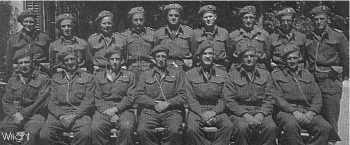|
|
|
It can fairly be claimed that in the New Zealand Division the Headquarters of the Divisional Artillery - universally known as "Div Arty" - was the most efficient of the second-tier command organisations. This was partly a result of luck, partly of circumstance. Under the heading of luck is the fact that effectively only three officers served as commander of the artillery (CRA) in the whole course of the war. (Brig. Parkinson, 'father of the pre-war RNZA' only got his chance in mid June 1944, but was recalled to the command of an infantry brigade a few weeks later. Brig Thornton did not succeed to the appointment until after the capture of Trieste.) The first appointee (Reggie Miles) was the ideal candidate. Intelligent and forceful, he had had extensive experience in field artillery in WW I and been three times wounded; between the wars he had command experience and additional technical training. He undertook the final training of the WW2 Regiments as soon as they were assembled overseas. When Div Arty was over-run in the Belhamed battle in November 1941, he was taken prisoner and died in captivity. That loss was severe, but it was providential that an outstanding regimental commander was available to replace Miles. This was the celebrated "Steve" Weir, already the holder of a DSO and bar (from Greece and Crete). Positive, ever cheerful and dynamic, he was to remain in office for two and a half years, during which period he introduced new and effective fire control methods, and set the tone for the Divisional Artillery. When Steve Weir was appointed to command the artillery of a British Corps in September 1944, the third dominant commander of Div Arty took office. This was Ray Queree, a pre-war regular officer who had had experience both in regimental command (4 Fd Regt, 5 Fd Regt) and had served with distinction as a staff officer in Div HQ. Highly professional, uncompromising, a strong disciplinarian and a master of detail, he controlled the increasing number of guns becoming available for the support of the NZ Division throughout the advance on Trieste. A second factor in the standard achieved in Div Arty was that the staff employed there had to be of special quality. Like all Operations staff officers they had to know all the "normal" control procedures, but Gunner staff also had to have the technical skills to manage the fire control of (often) large numbers of guns. These men were key figures; their names have largely passed into history. But those who depended on them "to get it right" remember their skills. Thirdly, Div Arty was usually an "uncluttered" area, as least in comparison with the average Infantry Brigade, which habitually had large numbers of subordinate units tacked on to the Brigade area. Whatever the explanation, Div Arty functioned with great efficiency throughout the war. Steve Weir's invariable practice of attaching himself directly to Gen Freyberg's small fighting or "tactical" headquarters throughout the highly mobile operations after Alamein must have been a blessing to his staff, battling to keep Regiments in close touch! Capable commanders make their own decisions. It is of interest that while the Division was being mobilised, CRA Miles made no haste about creating his own headquarters. He could see that at that stage there was no role for it. While the three field regiments (and half of 7 Anti Tank) were dribbling into mobilisation camps, there were sufficient Regular and TF personnel available to oversee basic training, while administrative support in other matters (including mobilisation requirements) was forthcoming from the peacetime District or Command Headquarters. The timetable that was achieved is set out in "W.E.Murphy" which relates that Miles did not have his full command together until May of 1941.
Back: Capt Stenberg (Sigs) 2Lt Wilson (Sigs) Capt Chapman (EME)
Capt Pledger (IO) Capt McSkimming (Sen.LO) 2Lt Webber (ACMO)
Rev Marlow (Chaplain) Lt Harris (LO) Lt Haughey (LO)
Text: LtGen Sir Leonard Thornton, KCB, CBE (1999) |

 HQRA 2 NZDiv 2 May 1945
HQRA 2 NZDiv 2 May 1945